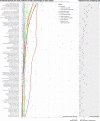Early ICD implantation following out-of-hospital cardiac arrest: a retrospective cohort study from the Swedish Registry for Cardiopulmonary Resuscitation
- PMID: 38309758
- PMCID: PMC10840024
- DOI: 10.1136/bmjopen-2023-077137
Early ICD implantation following out-of-hospital cardiac arrest: a retrospective cohort study from the Swedish Registry for Cardiopulmonary Resuscitation
Abstract
Background: It is unclear whether an implantable cardioverter-defibrillator (ICD) is generally beneficial in survivors of out-of-hospital cardiac arrest (OHCA).
Objective: We studied the association between ICD implantation prior to discharge and survival in patients with cardiac aetiology or initial shockable rhythm in OHCA.
Design: We conducted a retrospective cohort study in the Swedish Registry for Cardiopulmonary Resuscitation. Treatment associations were estimated using propensity scores. We used gradient boosting, Bayesian additive regression trees, neural networks, extreme gradient boosting and logistic regression to generate multiple propensity scores. We selected the model yielding maximum covariate balance to obtain weights, which were used in a Cox regression to calculate HRs for death or recurrent cardiac arrest.
Participants: All cases discharged alive during 2010 to 2020 with a cardiac aetiology or initial shockable rhythm were included. A total of 959 individuals were discharged with an ICD, and 2046 were discharged without one.
Results: Among those experiencing events, 25% did so within 90 days in the ICD group, compared with 52% in the other group. All HRs favoured ICD implantation. The overall HR (95% CI) for ICD versus no ICD was 0.38 (0.26 to 0.56). The HR was 0.42 (0.28 to 0.63) in cases with initial shockable rhythm; 0.18 (0.06 to 0.58) in non-shockable rhythm; 0.32 (0.20 to 0.53) in cases with a history of coronary artery disease; 0.36 (0.22 to 0.61) in heart failure and 0.30 (0.13 to 0.69) in those with diabetes. Similar associations were noted in all subgroups.
Conclusion: Among survivors of OHCA, those discharged with an ICD had approximately 60% lower risk of death or recurrent cardiac arrest. A randomised trial is warranted to study this further.
Keywords: Cardiac Epidemiology; Cardiopulmonary Resuscitation; Out-of-Hospital Cardiac Arrest.
© Author(s) (or their employer(s)) 2024. Re-use permitted under CC BY. Published by BMJ.
Conflict of interest statement
Competing interests: None declared.
Figures



References
-
- Goldenberg I, Gillespie J, Moss AJ, et al. . Long-term benefit of primary prevention with an implantable cardioverter-defibrillator: an extended 8-year follow-up study of the Multicenter Automatic Defibrillator Implantation Trial II. Circulation 2010;122:1265–71. 10.1161/CIRCULATIONAHA.110.940148 - DOI - PubMed
-
- Tamaki S, Yamada T, Okuyama Y, et al. . Cardiac Iodine-123 Metaiodobenzylguanidine Imaging Predicts Sudden Cardiac Death Independently of Left Ventricular Ejection Fraction in Patients With Chronic Heart Failure and Left Ventricular Systolic Dysfunction. Journal of the American College of Cardiology 2009;53:426–35. 10.1016/j.jacc.2008.10.025 - DOI - PubMed
Publication types
MeSH terms
LinkOut - more resources
Full Text Sources
Medical
